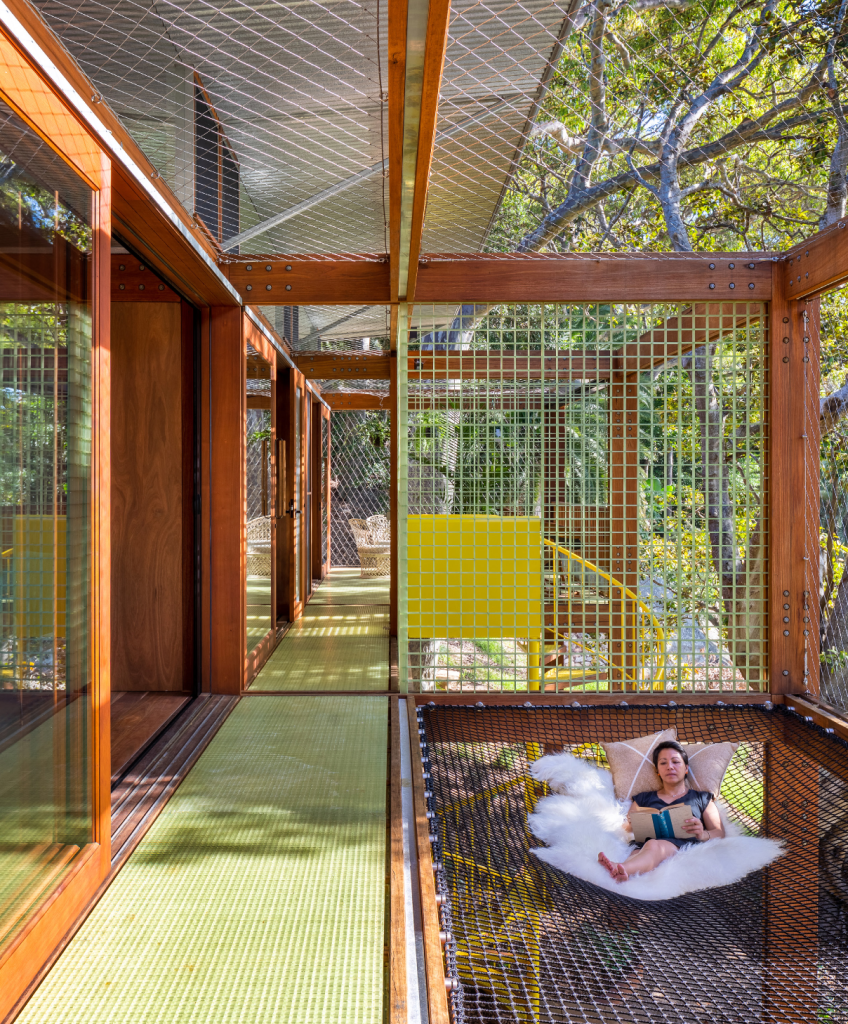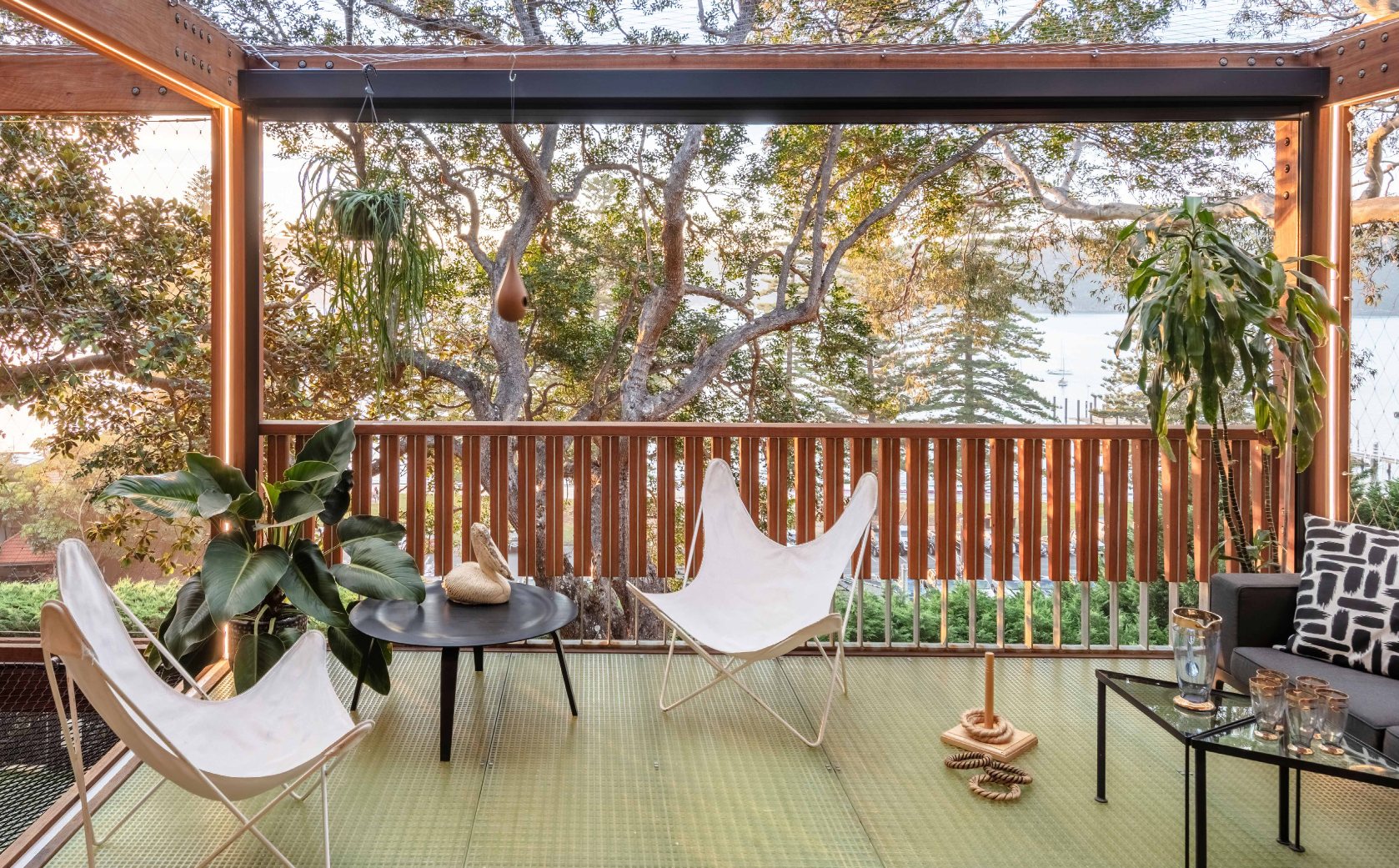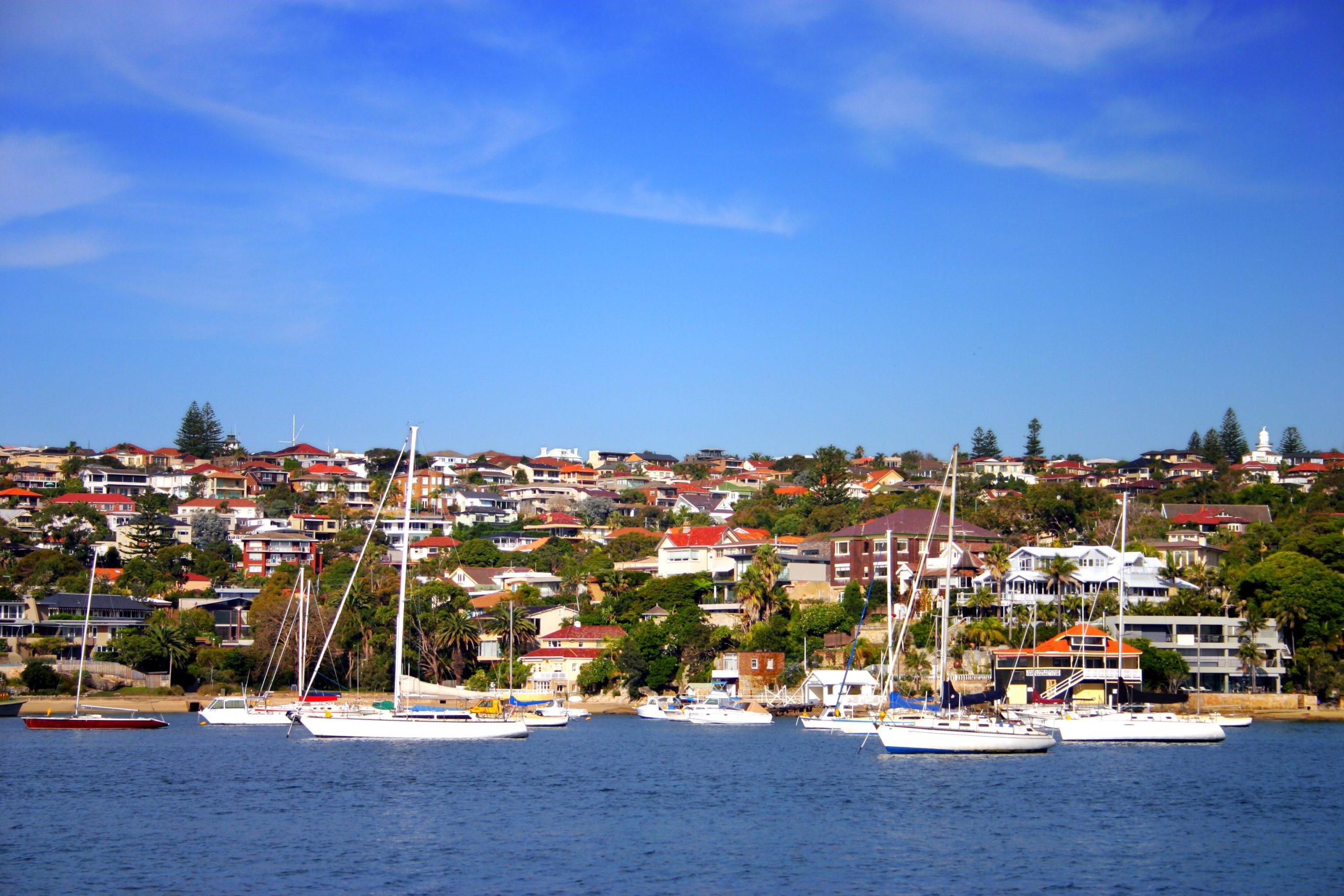Among The Scent Of Eucalyptus
It’s what hasn’t changed on this site that makes this residence so exceptional
When talk turns to sustainability in residential construction, certain aspects spring to mind. Solar panels tend to feature heavily, as do rainwater tanks and heat pumps. In fact it’s often the things that are added onto a project that tend to garner the most attention.
But there’s another way of viewing sustainable design and construction which has more in common with the ‘touch the earth lightly’ approach to architecture than some might think.
As both an architect and builder, Clinton Cole understands how to find that sweet spot between elegant, functional residential design and efficient, waste-less building practices.
By the time he was invited to design this property at Palm Beach, he had already worked with the owners to design and build their family home on Sydney’s lower north shore. Nicknamed Iron Maiden, that house is defined by an open air corridor running through its heart, turning the house on a corner site back in on itself and keeping the inhabitants consistently connected to changing weather conditions while creating a variety of common living spaces and private sleeping quarters.
So when they had the opportunity to design and build a holiday home on this idyllic coastal site on the fringe of Sydney’s Northern Beaches, it was no surprise that connection to the natural world would be at its heart. Having trusted him to build their permanent family residence, the owners asked Cole to help them select the right block from a choice of three possible options.

“Someone had bought the land 20 or 30 years ago as a superannuation plan and divided the site into three parts and my clients bought the middle one, so it’s a greenfield site,” he says.
“This was the one with the most natural beauty.”
With five mature trees and a large sandstone boulder on site, it was never in doubt that this project would work with the landscape rather than attempting to bend it to the designer’s will.
Instead of excavating, Cole designed a single level house on stilts that would connect with the tree canopy as much as possible.

“Carving the house into the hill wasn’t an option – why excavate the very landscape we’re celebrating? So we decided to plant it in the ground on bored concrete piers,” he says.
“The idea was to have the house feel like a cubby house. With five trees on the site we had to get (the house) to a certain level to get to the canopy. Then we 3D scaled each tree and each leaf so we could carefully place the building and every tree would be safe.”
The digitised version of the trees, including a Port Jackson fig that was subject to a conservation order, formed part of the approval process with council and meant that when the house was complete, the residents could immediately enjoy the benefits of living in close proximity to mature trees.
The house itself is a simple design — “it took 10 minutes to design” says Cole — which is in keeping with the lifestyle the owners were hoping to capture. There’s not even space wasted on an internal corridor, so that a trip to the bathroom requires guests to momentarily step onto the deck before going back indoors. A spiral staircase is the only sculptural element to compete with the natural beauty of the site.
“It wasn’t about making a statement,” he says. “You don’t see it from the street so that was a low priority. It was designed so that you could walk around barefoot or have a shower at the back of the stairs after walking back from the beach.”
Materials are simple but have nonetheless been chosen with care. The framework consists of kiln dried Australian blackbutt and steel flitch beams with spotted gum lining the internal walls. The ceiling and roof are made up of lightweight galvanised iron sheeting while the outdoor flooring is fibre reinforced plastic (FRP). Cole says all materials, including the FRP, have been chosen for longevity.

“FRP is used on oil rigs and marine environments because it’s bulletproof,” he says. “That’s one of the higher embodied energy materials we used here but compared with timber decking, this comes out way ahead. It lasts about four times as long as timber.”
Heavy netting has also been used as an unconventional flooring/ seating option as well as ‘screening’ to add to the sense of living amongst the trees.
“The netting kept the terrace area really light,” says Cole. “I got the idea when I was at indoor cricket sitting behind the net. After a couple of minutes the netting disappears visually.”
In keeping with its summertime vibes, the outdoor areas are almost the same size as the indoor spaces, with large, timber framed sliding doors retracting to maximise the living area. Meant for hosting visiting family, the house has a holiday feel with built-in double bunk beds in the secondary bedroom ideal for sleepovers.
Keeping in mind the amount of waste typically generated on building sites, Cole designed the house ‘like a Meccano set’.
“Because of the distance in terms of travel time from the (inner city) office and I am usually on site once or twice a week, I designed it to be built without supervision, like a Meccano set, shaping bits
of timber, cutting to length and drilling the holes and putting bits into holes,” he says.
It was just as well, given the lockdown periods Sydney — and the Northern Beaches — went through when the house was being built. As a result, he only visited the site twice in the six months it took to build.

“Normally you wouldn’t be able to build a basement in that time if you were dealing with excavation,”
Cole says. “It was appropriate for the site, as well as the budget.”
Relying on passive design principles such as cross ventilation and the thermal chimney effect where rising hot air is released from the house via strategically placed louvred vents, the only obvious concessions to conventional cooling methods are ceiling fans in the living room and bedrooms.
Because the trees have been retained, solar panels were not considered suitable for this house — ‘it’s too overshadowed’ — so its sustainable credentials are not obvious.
“It’s not the most prevalent sustainability project,” says Cole. “There are no solar panels or heat pumps, it has none of those things.
“But half the carbon in a building is not in the life cycle of the building, it’s in the resources that go into building it. We worked on the embodied energy being as low as possible. It’s something we’re doing more and more.”
This stylish family home combines a classic palette and finishes with a flexible floorplan
Just 55 minutes from Sydney, make this your creative getaway located in the majestic Hawkesbury region.
Ahead of the Games, a breakdown of the city’s most desirable places to live
PARIS —Paris has long been a byword for luxurious living. The traditional components of the upscale home, from parquet floors to elaborate moldings, have their origins here. Yet settling down in just the right address in this low-rise, high-density city may be the greatest luxury of all.
Tradition reigns supreme in Paris real estate, where certain conditions seem set in stone—the western half of the city, on either side of the Seine, has long been more expensive than the east. But in the fashion world’s capital, parts of the housing market are also subject to shifting fads. In the trendy, hilly northeast, a roving cool factor can send prices in this year’s hip neighborhood rising, while last year’s might seem like a sudden bargain.
This week, with the opening of the Olympic Games and the eyes of the world turned toward Paris, The Wall Street Journal looks at the most expensive and desirable areas in the City of Light.
The Most Expensive Arrondissement: the 6th
Known for historic architecture, elegant apartment houses and bohemian street cred, the 6th Arrondissement is Paris’s answer to Manhattan’s West Village. Like its New York counterpart, the 6th’s starving-artist days are long behind it. But the charm that first wooed notable residents like Gertrude Stein and Jean-Paul Sartre is still largely intact, attracting high-minded tourists and deep-pocketed homeowners who can afford its once-edgy, now serene atmosphere.
Le Breton George V Notaires, a Paris notary with an international clientele, says the 6th consistently holds the title of most expensive arrondissement among Paris’s 20 administrative districts, and 2023 was no exception. Last year, average home prices reached $1,428 a square foot—almost 30% higher than the Paris average of $1,100 a square foot.
According to Meilleurs Agents, the Paris real estate appraisal company, the 6th is also home to three of the city’s five most expensive streets. Rue de Furstemberg, a secluded loop between Boulevard Saint-Germain and the Seine, comes in on top, with average prices of $2,454 a square foot as of March 2024.
For more than two decades, Kyle Branum, a 51-year-old attorney, and Kimberly Branum, a 60-year-old retired CEO, have been regular visitors to Paris, opting for apartment rentals and ultimately an ownership interest in an apartment in the city’s 7th Arrondissement, a sedate Left Bank district known for its discreet atmosphere and plutocratic residents.
“The 7th was the only place we stayed,” says Kimberly, “but we spent most of our time in the 6th.”
In 2022, inspired by the strength of the dollar, the Branums decided to fulfil a longstanding dream of buying in Paris. Working with Paris Property Group, they opted for a 1,465-square-foot, three-bedroom in a building dating to the 17th century on a side street in the 6th Arrondissement. They paid $2.7 million for the unit and then spent just over $1 million on the renovation, working with Franco-American visual artist Monte Laster, who also does interiors.
The couple, who live in Santa Barbara, Calif., plan to spend about three months a year in Paris, hosting children and grandchildren, and cooking after forays to local food markets. Their new kitchen, which includes a French stove from luxury appliance brand Lacanche, is Kimberly’s favourite room, she says.
Another American, investor Ashley Maddox, 49, is also considering relocating.
In 2012, the longtime Paris resident bought a dingy, overstuffed 1,765-square-foot apartment in the 6th and started from scratch. She paid $2.5 million and undertook a gut renovation and building improvements for about $800,000. A centrepiece of the home now is the one-time salon, which was turned into an open-plan kitchen and dining area where Maddox and her three children tend to hang out, American-style. Just outside her door are some of the city’s best-known bakeries and cheesemongers, and she is a short walk from the Jardin du Luxembourg, the Left Bank’s premier green space.
“A lot of the majesty of the city is accessible from here,” she says. “It’s so central, it’s bananas.” Now that two of her children are going away to school, she has listed the four-bedroom apartment with Varenne for $5 million.
The Most Expensive Neighbourhoods: Notre-Dame and Invalides
Garrow Kedigian is moving up in the world of Parisian real estate by heading south of the Seine.
During the pandemic, the Canada-born, New York-based interior designer reassessed his life, he says, and decided “I’m not going to wait any longer to have a pied-à-terre in Paris.”
He originally selected a 1,130-square-foot one-bedroom in the trendy 9th Arrondissement, an up-and-coming Right Bank district just below Montmartre. But he soon realised it was too small for his extended stays, not to mention hosting guests from out of town.
After paying about $1.6 million in 2022 and then investing about $55,000 in new decor, he put the unit up for sale in early 2024 and went house-shopping a second time. He ended up in the Invalides quarter of the 7th Arrondissement in the shadow of one Paris’s signature monuments, the golden-domed Hôtel des Invalides, which dates to the 17th century and is fronted by a grand esplanade.
His new neighbourhood vies for Paris’s most expensive with the Notre-Dame quarter in the 4th Arrondissement, centred on a few islands in the Seine behind its namesake cathedral. According to Le Breton, home prices in the Notre-Dame neighbourhood were $1,818 a square foot in 2023, followed by $1,568 a square foot in Invalides.
After breaking even on his Right Bank one-bedroom, Kedigian paid $2.4 million for his new 1,450-square-foot two-bedroom in a late 19th-century building. It has southern exposures, rounded living-room windows and “gorgeous floors,” he says. Kedigian, who bought the new flat through Junot Fine Properties/Knight Frank, plans to spend up to $435,000 on a renovation that will involve restoring the original 12-foot ceiling height in many of the rooms, as well as rescuing the ceilings’ elaborate stucco detailing. He expects to finish in 2025.
Over in the Notre-Dame neighbourhood, Belles demeures de France/Christie’s recently sold a 2,370-square-foot, four-bedroom home for close to the asking price of about $8.6 million, or about $3,630 a square foot. Listing agent Marie-Hélène Lundgreen says this places the unit near the very top of Paris luxury real estate, where prime homes typically sell between $2,530 and $4,040 a square foot.
The Most Expensive Suburb: Neuilly-sur-Seine
The Boulevard Périphérique, the 22-mile ring road that surrounds Paris and its 20 arrondissements, was once a line in the sand for Parisians, who regarded the French capital’s numerous suburbs as something to drive through on their way to and from vacation. The past few decades have seen waves of gentrification beyond the city’s borders, upgrading humble or industrial districts to the north and east into prime residential areas. And it has turned Neuilly-sur-Seine, just northwest of the city, into a luxury compound of first resort.
In 2023, Neuilly’s average home price of $1,092 a square foot made the leafy, stately community Paris’s most expensive suburb.
Longtime residents, Alain and Michèle Bigio, decided this year is the right time to list their 7,730-square-foot, four-bedroom townhouse on a gated Neuilly street.
The couple, now in their mid 70s, completed the home in 1990, two years after they purchased a small parcel of garden from the owners next door for an undisclosed amount. Having relocated from a white-marble château outside Paris, the couple echoed their previous home by using white- and cream-coloured stone in the new four-story build. The Bigios, who will relocate just back over the border in the 16th Arrondissement, have listed the property with Emile Garcin Propriétés for $14.7 million.
The couple raised two adult children here and undertook upgrades in their empty-nester years—most recently, an indoor pool in the basement and a new elevator.
The cool, pale interiors give way to dark and sardonic images in the former staff’s quarters in the basement where Alain works on his hobby—surreal and satirical paintings, whose risqué content means that his wife prefers they stay downstairs. “I’m not a painter,” he says. “But I paint.”
The Trendiest Arrondissement: the 9th
French interior designer Julie Hamon is theatre royalty. Her grandfather was playwright Jean Anouilh, a giant of 20th-century French literature, and her sister is actress Gwendoline Hamon. The 52-year-old, who divides her time between Paris and the U.K., still remembers when the city’s 9th Arrondissement, where she and her husband bought their 1,885-square-foot duplex in 2017, was a place to have fun rather than put down roots. Now, the 9th is the place to do both.
The 9th, a largely 19th-century district, is Paris at its most urban. But what it lacks in parks and other green spaces, it makes up with nightlife and a bustling street life. Among Paris’s gentrifying districts, which have been transformed since 2000 from near-slums to the brink of luxury, the 9th has emerged as the clear winner. According to Le Breton, average 2023 home prices here were $1,062 a square foot, while its nearest competitors for the cool crown, the 10th and the 11th, have yet to break $1,011 a square foot.
A co-principal in the Bobo Design Studio, Hamon—whose gut renovation includes a dramatic skylight, a home cinema and air conditioning—still seems surprised at how far her arrondissement has come. “The 9th used to be well known for all the theatres, nightclubs and strip clubs,” she says. “But it was never a place where you wanted to live—now it’s the place to be.”
With their youngest child about to go to college, she and her husband, 52-year-old entrepreneur Guillaume Clignet, decided to list their Paris home for $3.45 million and live in London full-time. Propriétés Parisiennes/Sotheby’s is handling the listing, which has just gone into contract after about six months on the market.
The 9th’s music venues were a draw for 44-year-old American musician and piano dealer, Ronen Segev, who divides his time between Miami and a 1,725-square-foot, two-bedroom in the lower reaches of the arrondissement. Aided by Paris Property Group, Segev purchased the apartment at auction during the pandemic, sight unseen, for $1.69 million. He spent $270,000 on a renovation, knocking down a wall to make a larger salon suitable for home concerts.
During the Olympics, Segev is renting out the space for about $22,850 a week to attendees of the Games. Otherwise, he prefers longer-term sublets to visiting musicians for $32,700 a month.
Most Exclusive Address: Avenue Junot
Hidden in the hilly expanses of the 18th Arrondissement lies a legendary street that, for those in the know, is the city’s most exclusive address. Avenue Junot, a bucolic tree-lined lane, is a fairy-tale version of the city, separate from the gritty bustle that surrounds it.
Homes here rarely come up for sale, and, when they do, they tend to be off-market, or sold before they can be listed. Martine Kuperfis—whose Paris-based Junot Group real-estate company is named for the street—says the most expensive units here are penthouses with views over the whole of the city.
In 2021, her agency sold a 3,230-square-foot triplex apartment, with a 1,400-square-foot terrace, for $8.5 million. At about $2,630 a square foot, that is three times the current average price in the whole of the 18th.
Among its current Junot listings is a 1930s 1,220-square-foot townhouse on the avenue’s cobblestone extension, with an asking price of $2.8 million.
This stylish family home combines a classic palette and finishes with a flexible floorplan
Just 55 minutes from Sydney, make this your creative getaway located in the majestic Hawkesbury region.


















